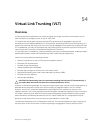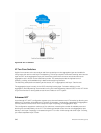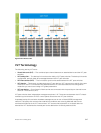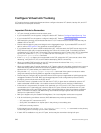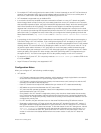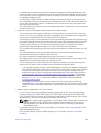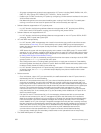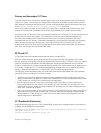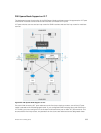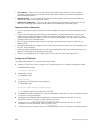
Primary and Secondary VLT Peers
To prevent issues when connectivity between peers is lost, you can designate Primary and Secondary
roles for VLT peers . You can elect or configure the Primary Peer. By default, the peer with the lowest
MAC address is selected as the Primary Peer. You can configure another peer as the Primary Peer using
the VLT domain domain-id role priority priority-value command.
If the VLTi link fails, the status of the remote VLT Primary Peer is checked using the backup link. If the
remote VLT Primary Peer is available, the Secondary Peer disables all VLT ports to prevent loops.
If all ports in the VLTi link fail or if the communication between VLTi links fails, VLT checks the backup link
to determine the cause of the failure. If the failed peer can still transmit heartbeat messages, the
Secondary Peer disables all VLT member ports and any Layer 3 interfaces attached to the VLAN
associated with the VLT domain. If heartbeat messages are not received, the Secondary Peer forwards
traffic assumes the role of the Primary Peer. If the original Primary Peer is restored, the VLT peer
reassigned as the Primary Peer retains this role and the other peer must be reassigned as a Secondary
Peer. Peer role changes are reported as SNMP traps.
RSTP and VLT
VLT provides loop-free redundant topologies and does not require RSTP.
RSTP can cause temporary port state blocking and may cause topology changes after link or node
failures. Spanning tree topology changes are distributed to the entire layer 2 network, which can cause a
network-wide flush of learned MAC and ARP addresses, requiring these addresses to be re-learned.
However, enabling RSTP can detect potential loops caused by non-system issues such as cabling errors
or incorrect configurations. To minimize possible topology changes after link or node failure, RSTP is
useful for potential loop detection. Configure RSTP using the following specifications.
The following recommendations help you avoid these issues and the associated traffic loss caused by
using RSTP when you enable VLT on both VLT peers:
• Configure any ports at the edge of the spanning tree’s operating domain as edge ports, which are
directly connected to end stations or server racks. Disable RSTP on ports connected directly to Layer
3-only routers not running STP or configure them as edge ports.
• Ensure that the primary VLT node is the root bridge and the secondary VLT peer node has the
second-best bridge ID in the network. If the primary VLT peer node fails, the secondary VLT peer
node becomes the root bridge, avoiding problems with spanning tree port state changes that occur
when a VLT node fails or recovers.
• Even with this configuration, if the node has non-VLT ports using RSTP that you did not configure as
edge ports and are connected to other Layer 2 switches, spanning tree topology changes are still
detected after VLT node recovery. To avoid this scenario, ensure that you configure any non-VLT
ports as edge ports or disable RSTP.
VLT Bandwidth Monitoring
When bandwidth usage of the VLTi (ICL) exceeds 80%, a syslog error message (shown in the following
message) and an SNMP trap are generated.
%STKUNIT0-M:CP %VLTMGR-6-VLT-LAG-ICL: Overall Bandwidth utilization of VLT-ICL-
LAG (port-channel 25)
crosses threshold. Bandwidth usage (80 )
Virtual Link Trunking (VLT)
953



